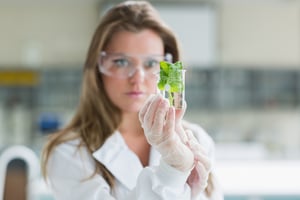For workers who routinely deal with hazardous chemicals, light or equipment, eye protection is critical to securing a safe environment.
While many slip on lab safety glasses before beginning a project, the eyewear they choose may not provide adequate protection. Safety glasses, goggles and face shields all provide some eye or face protection. Even different types of each eyewear offer a different level of protection against eye injuries depending on what types of hazards you are working with in your lab space.
Let’s begin with exploring whether lab safety glasses provide the protection your workers need, and if not, what personal protective equipment will.
Lab Safety Glasses
Lab safety glasses often have shatter-resistant lenses and are designed to stop large objects from injuring eyes. 
For the best impact protection, make sure the lab safety glasses you are using has an ANSI Z87.1 rating. The American National Standards Institute (ANSI) regulates safety standards and implements a defined set of tests that a piece of PPE must pass in order to be labeled as meeting the appropriate ANSI standards.
In addition to work environments where there are potential risks of propelled objects, safety glasses also are designed to provide laser light filtration or to prevent laser reflections that can cause retinal burns from entering the eye.
Another advantage of lab safety glasses is that many manufacturers will allow you to purchase them with prescription lenses for those who frequently wear them.
However, safety glasses do not offer as much protection from liquids and vapors as safety goggles, since this type of safety eyewear does not create a seal to the face and hazardous materials can enter from the sides. This can be of particular concern to prescription contact wearers who must be careful of dust and chemical hazards becoming trapped between the contact and eye.
A lab safety glass lens is typically made from either a material like polycarbonate or propionate plastic. Propionate plastic is nylon-based and the resulting design is strong and lightweight. Polycarbonate originally found its niche in aerospace applications, used in astronaut’s helmet visors in the 1970s. Since then, it’s become a popular material for lab safety glasses due to its impact resistance and natural UV protection.
Other Protective Eyewear
If your lab workers regularly deal with chemicals, bloodborne pathogens or other substances that produce mists, vapors or fumes, it may be more appropriate to have lab safety goggles on hand for their protection.
There are two types of lab goggles: vented and non-vented.
Non-vented goggles protect a worker’s eyes from vapors, mists and fumes, as well as any other hazards that would require eyes to be completely shielded such as chemicals or bloodborne pathogens.
Vented goggles provide a moderate amount of protection from liquids as long as they do not emit vapors or mist. Some laboratory goggles allow air to pass through but include a physical barrier to liquids. Other vented goggles, like those found at a hardware store that have holes in the plastic, would not be suitable for some lab environments.
Like lab glasses, the goggles you select should meet ANSI safety standards. The literature that accompanies the safety goggles should clearly show that the equipment has met standard ANSI-Z87. On the goggles themselves, they should have a label that says “Z87.”
Additional markings will identify other protections including splash (D3), dust (D4) or fine dust (D5). For example, chemical splash goggles would have a label that looks like, “Z87+D3.” If you want protection from both splashes and dust, you should look for a label that reads, “Z87+D3D4.”
In addition to goggles, another option for your workplace are face shields. Keep in mind that face shields are not designed to be the only appropriate eye protection a lab worker should wear. Instead, they can help provide additional protection when worn over eye protection glasses or goggles. Face shields also help protect the entire face, rather than only eyes.
Finding The Right Lab Safety Glasses
The ultimate goals of any lab space should be to maximize safety and improve compliance. Often, wearing lab safety glasses isn't the most comfortable form of PPE. However, lab safety rules should always stress wearing the appropriate personal protective equipment, whether it’s clean room garments like lab coats, coveralls and full body suits, or pieces like gloves, respirators and safety glasses.
A few actions you can take to help improve compliance is to prioritize the comfort of the protective eyewear you choose. For example, safety glasses come in different weights. While it’s important to always meet ANSI standards, opt for a model that has a light feel to it.
Some safety glasses models also feature rubber nosepieces, which keep them from sliding around the face and reducing their effectiveness. Flexible earpieces can also keep glasses from sliding and help you fit the glasses to the widest range of individuals.
Even with policies and protocols in place, accidents still occur, which is why it’s critical that you provide comfortable, yet effective, protection against harmful variables found in all science labs. While lab safety glasses may provide the level of protection your employees need, it’s important as an employer to explore alternatives like goggles if there are greater potential exposures present.


